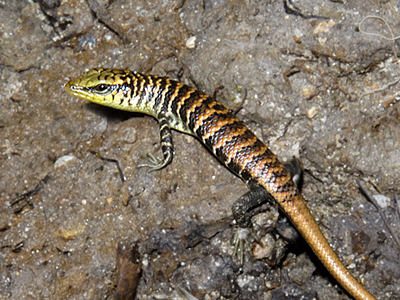Olive Tree Skink Care Sheet
Housing
As this lizard is going to get to around 10 inches when adult it will require a vivarium of at least 36 inches long and 12 inches wide. These measurements are of course the minimum requirements, but you can always move up to a larger enclosure if you want.
The enclosure should be at least 18 inches high to allow you to include some branches.
Heating
The temperature should be kept at around 26C – 30C during the day and 22C – 25C at night. The best way to accomplish this is to use a basking spot of around 60W at one end of the enclosure and a heat pack under the substrate beneath the spot lamp. The other end of the vivarium should not be heated, this will create a warmer and a cooler end.
The heat mat should be left on 24 hours a day
Lighting
As this is a day active lizard it will need UV radiation in order for its bones to stay healthy.
A UV strip light should be fitted so that UV tubes can be used to both light the enclosure and provide the necessary light for the lizard. Go for a tube that emits 5% UVB There should always be a basking area for day active lizards, this should be the hottest place in the vivarium and allows the lizards to get to their best ‘operating temperature’.
Aim to get the temperature under the spot light to 30C
Tubes or piles of cork should be provided at both ends, one under the lights and one at the cool end, this will allow the lizard to hide in either the warm or cooler end of the vivarium.
The spot light and UV light should be left on for 12 hours a day, this can easily be accomplished using a simple timer switch.
Decor
The Green Dasia as a good climber, this must be provided in the habitat in order for them to act naturally.
Use a tree branch (not pine) with plenty of side shoots, this should be stripped of leaves and washed before using it in the enclosure.
There should be at least two hides in the enclosure for each lizard, this will allow then to make their ‘own space’ and they will feel more comfortable knowing that shelter is nearby.
To give the lizards a little extra sense of security the branches should be wrapped with bushy green artificial plants, this will allow the lizards to feel ‘invisible’ and allow them to adopt that all important natural behaviour.
Substrate
The Olive Tree Skink is from the fairly constantly warm region around the Philippines. It is found living in forests and semi open areas.
In the vivarium you will need to provide a suitable substrate which will release humidity.
Orchid bark or forest substrate can be used for the substrate, and it should be fairly dry when first adding it to the enclosure, if it’s wet the whole tank will steam up!
Vary the thickness from 2 inches to 4 inches at the cool end, this will allow the lizards to get buried if they want.
Spray the surface of the compost every morning and late afternoon, this will help raise the humidity in the tank – it shouldn’t be wet. The windows will temporarily steam up.
Food & Water
These charming little lizards will readily drink from a water bowl rather than having to spray it on the walls.
Use a smooth sided bowl or around 5 x 4 inches and 1 inch deep.
These lizards are carnivores and will readily eat any of the commercially available foods like medium crickets, mealworm, medium locust and waxworm.
Feed 3 – 4 items per day per lizard and do it during daylight hours.
They are also known to eat soft fruits, tender leaves and flowers. Put some chopped fruit in a small dish once a week, if the lizard wants it then food is always available.
If not, the crickets will eat it during the night and then when the lizard then eats the crcket it is also getting the fruit!
After the introduction period the lizard will become more settled and start behaving naturally by burying itself in the sand as described above and basking in the hottest places.
This is when you can really see the nature of the Olive Tree Skink.
For the first week or so the lizard will explore the vivarium and the plants and decor to find the best hiding, hunting and sleeping areas.
During this period you should avoid stressing the animal and should leave well alone other than feeding and watering, over time it will become used to your presence.
For any further information or advice please feel free to ask a staff member in store or contact the store on 01902 494860.




